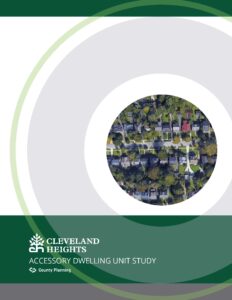
The Cleveland Heights Accessory Dwelling Unit (ADU) Study detailed the costs and benefits associated with ADUs, analyzed the city’s zoning code to see where limitations of constructing ADUs exist, and offered best practices for implementing ADUs in city ordinances.
Cleveland Heights ADU Study
The Accessory Dwelling Unit Study should be used to compose effective ADU policies. It’s tailored to the City of Cleveland Heights, but is designed as a best practices guide for other municipalities considering ADUs.
Background
The City of Cleveland Heights is faced with changing demographics, population loss, and shifting housing demands. The city desires to find a balance between affordability and revitalization within its housing market to stem population loss and attain its goal of pre-1970 population levels. ADUs are an increasingly important housing option across the United States, especially in older neighborhoods or built-out communities, where ADUs can help meet the demands of the housing market and fill a void for high-quality affordable housing within well-established residential neighborhoods.
ADUs are an incremental and attainable step towards housing affordability and lasting population growth, and although this ADU Study was in partnership with the City of Cleveland Heights, its findings are intended to be used as a guide for other communities that are considering implementing ADU regulations into their zoning codes and relevant ordinances.
Webinar
On November 18, 2024, County Planning hosted a webinar about ADUs, in partnership with the City of Cleveland Heights, APA Ohio Cleveland Section, and the Northeast Ohio First Suburbs Consortium.
Download the presentation
Process
This Accessory Dwelling Unit Study was conducted by the Cuyahoga County Planning Commission in partnership with the City of Cleveland Heights, and included the following six (6) project steps:
 Define ADUs: This phase included an analysis of the different forms of ADUs and the general site plans ADUs can take, as well as outlining common benefits and issues associated with integrating ADUs into City policies and regulations.
Define ADUs: This phase included an analysis of the different forms of ADUs and the general site plans ADUs can take, as well as outlining common benefits and issues associated with integrating ADUs into City policies and regulations.
 Research Cleveland Heights Policy Conformance: This phase included an extensive review of the City’s current zoning ordinances and planning documents to better understand how existing policies either support or are a potential hindrance to ADUs and their construction.
Research Cleveland Heights Policy Conformance: This phase included an extensive review of the City’s current zoning ordinances and planning documents to better understand how existing policies either support or are a potential hindrance to ADUs and their construction.
 Research Critical ADU Topics for Consideration: This phase included an in-depth review of modern best practices and national guidelines surrounding ADUs—including such topics as general zoning considerations (height, setbacks, lot coverage, parking, etc.), design standards, administrative processes, relationship to building codes, and performance requirements.
Research Critical ADU Topics for Consideration: This phase included an in-depth review of modern best practices and national guidelines surrounding ADUs—including such topics as general zoning considerations (height, setbacks, lot coverage, parking, etc.), design standards, administrative processes, relationship to building codes, and performance requirements.
 Conduct Outreach: This phase included various interviews with local and national experts in housing and/or have successfully implemented ADU regulations, as well as interested residents. These interviews included: two Cleveland Heights residents (one architect), a locally licensed realtor under the National Association of Realtors, a representative from the Cuyahoga County Fiscal Department, and the Cities of Anchorage, Alaska, Cincinnati, Ohio, and Bloomington, Indiana—who have each approached ADUs in different manners across their individual communities.
Conduct Outreach: This phase included various interviews with local and national experts in housing and/or have successfully implemented ADU regulations, as well as interested residents. These interviews included: two Cleveland Heights residents (one architect), a locally licensed realtor under the National Association of Realtors, a representative from the Cuyahoga County Fiscal Department, and the Cities of Anchorage, Alaska, Cincinnati, Ohio, and Bloomington, Indiana—who have each approached ADUs in different manners across their individual communities.
 Write Report & Recommendations: This phase outlined best practices for implementing ADU regulations and provided recommendations for how and where updates would need to be made within the City’s current Zoning Code to support ADUs as a viable housing option.
Write Report & Recommendations: This phase outlined best practices for implementing ADU regulations and provided recommendations for how and where updates would need to be made within the City’s current Zoning Code to support ADUs as a viable housing option.
 Present Findings: This phase included a final public presentation to the City’s Planning Commission about the study’s findings and what the next steps are for the City of Cleveland Heights and ADUs.
Present Findings: This phase included a final public presentation to the City’s Planning Commission about the study’s findings and what the next steps are for the City of Cleveland Heights and ADUs.
Contact Us
If you have any questions or comments relating to the Cleveland Heights Accessory Dwelling Unit Study, please use the contact information provided below. Thank you.
Rachel Novak, AICP
Senior Planner
rnovak@cuyahogacounty.us
Top image: 2300 block of Woodmere – Euclid Golf Allotment – Cleveland Heights Ohio by Tim Evanson; accessed 4/3/24; licensed under CC BY-SA 2.0

